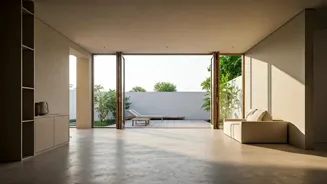Everything Has Its Place
This section outlines the importance of assigning specific storage locations for all your belongings, a foundational principle of minimalist design. Doing
so simplifies organization, making it easy to maintain a tidy and calming home environment. Examples provided include assigning specific areas for spices, shoes, and essential documents to avoid clutter.
Embrace Empty Space (Ma)
This section highlights the significance of 'Ma', or empty space, a vital element in minimalist design. This isn't just about emptiness; it's about using space deliberately to create a feeling of breathing room and visual balance. This concept helps reduce clutter and increases a sense of openness, fostering a relaxing and peaceful atmosphere.
Daily Rituals of Cleaning
Minimalist living encourages establishing a daily cleaning routine to maintain a tidy environment and prevent mess accumulation. Incorporating brief, daily tasks such as sweeping, wiping surfaces, or tidying up regularly will help in preserving the neatness and order. Consistent cleaning reduces stress and increases a sense of calm and satisfaction.
Less Furniture, More Flow
Choosing fewer pieces of furniture, while ensuring each piece serves multiple purposes, is a core aspect of minimalism. This approach enhances the flow of movement throughout your home, prevents overcrowding, and promotes a sense of spaciousness and functionality. The focus shifts to quality and versatility over a large quantity of items.
Seasonal Rotation Focus
Seasonal rotation involves updating your home décor and possessions to reflect the current time of year. By storing seasonal items and bringing out appropriate items, you can keep your living spaces feeling refreshed and aligned with the natural environment. This practice enables decluttering and encourages appreciation for seasonal changes.









